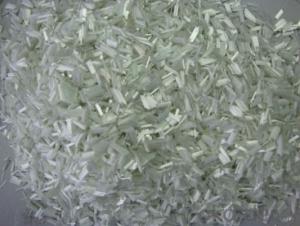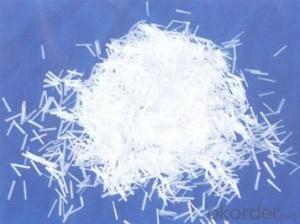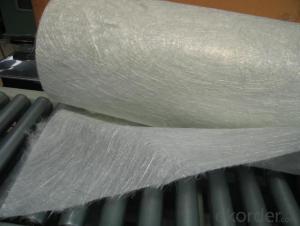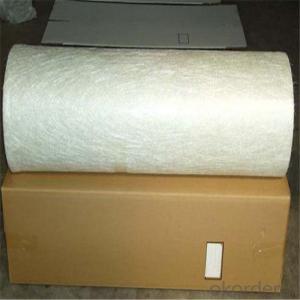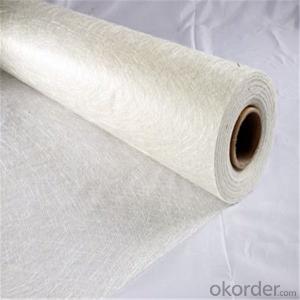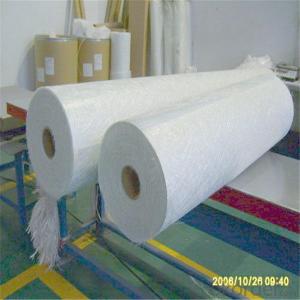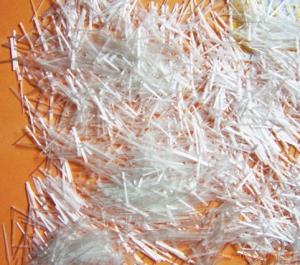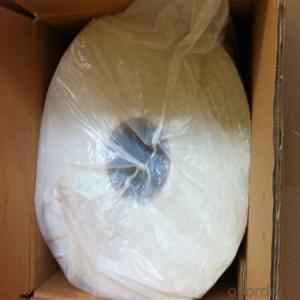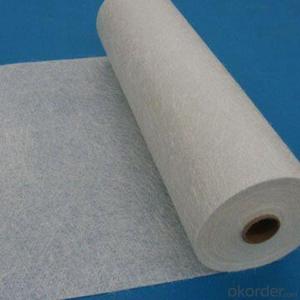E-glass Fiber Chopped Strands Produced By Wet Method
- Loading Port:
- Shanghai
- Payment Terms:
- TT or LC
- Min Order Qty:
- 20000 kg
- Supply Capability:
- 200000 kg/month
OKorder Service Pledge
OKorder Financial Service
You Might Also Like
Description:
E Glass Fiber Chopped Strands Produced By Wet Method are compatible with unsaturated polyester, epoxy and phenolic resins and gypsum.
Wet Chopped Strands have moderate moisture content and deliver outstanding flowability, including dispersion in water and in gypsum.

Product Features:
Excellent dispersion in water
Good bonding with multiple resins
Outstanding tensile and tear properties in the final product
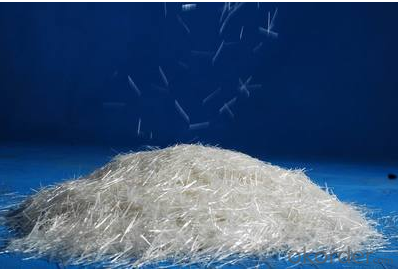
Product Specifications:
Property | Fibre diameter | Moisture Content | Size Content | Chop |
(%) | (%) | (%) | (%) | |
Mathods | IS01888 | ISO3344 | ISO1887 | |
3mm | ±10 | ≤3.0 | 0.1±0.05 | 98 |
6mm | ||||
12mm | ||||
18mm |
Special specification can be produce according to customer requirements.
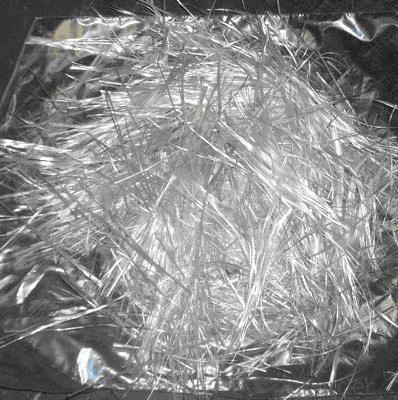
Packaging:
Each bag can be taken (15-25kgs)。 Could also take a big container bag.
Storage:
Unless otherwise specified, It should be stored in a dry, cool and rain-proof area. It is recommended that the room temperature and humidity should be always maintained at 15℃~35℃ and 35%~65% respectively.
FAQ:
1..Is your company a factory or trade company?
A:We have our own factory , we are on this business more than 10 years.
2.Who will pay for the express cost ?
A: We can support you free samples ,but express cost will be paid by you .
3.How long is the delivery time?
A:within 10-15 days after receiving deposit.
- Q:What are the typical tensile and flexural strengths of chopped strand composites?
- The typical tensile and flexural strengths of chopped strand composites can vary depending on several factors such as the type and quantity of reinforcement fibers used, the resin matrix, and the manufacturing process employed. However, in general, chopped strand composites tend to exhibit good tensile and flexural strengths. Tensile strength refers to the maximum stress a material can withstand before breaking under tension. Chopped strand composites typically have tensile strengths ranging from 100 to 500 megapascals (MPa) or more, depending on the specific composition and processing conditions. The reinforcing fibers, such as glass or carbon, play a crucial role in enhancing the tensile strength of these composites by distributing the applied load and providing resistance to deformation. Flexural strength, also known as the modulus of rupture, measures a material's ability to withstand bending forces without fracturing. Chopped strand composites generally exhibit flexural strengths in the range of 80 to 300 MPa, although higher values can be achieved with advanced reinforcement techniques and optimized resin systems. It is important to note that these values are approximate and can vary significantly depending on the specific application and design requirements. Additionally, the mechanical properties of chopped strand composites can be further enhanced through the use of additives, such as fillers or nanoparticles, and by optimizing the manufacturing process parameters, such as fiber orientation and resin curing conditions. Therefore, it is recommended to consult with experts or conduct specific testing to determine the exact tensile and flexural strengths for a particular chopped strand composite system.
- Q:Is fiberglass chopped strand suitable for the production of playground equipment?
- Yes, fiberglass chopped strand is suitable for the production of playground equipment. It offers excellent strength, durability, and resistance to harsh weather conditions, making it a reliable material choice for playground structures. Additionally, fiberglass chopped strand can be easily molded into various shapes and designs, providing flexibility in creating customized playground equipment.
- Q:Is fiberglass chopped strand suitable for applications requiring dimensional stability?
- Fiberglass chopped strand is generally not suitable for applications requiring high dimensional stability. Chopped strand refers to short strands of fiberglass that are randomly oriented and bound together. This random orientation can result in a lack of uniformity and consistency in the material, leading to potential dimensional changes over time. For applications requiring dimensional stability, other forms of fiberglass reinforcement, such as woven or continuous strand, are typically preferred. These forms of fiberglass provide a more controlled and consistent reinforcement, reducing the likelihood of dimensional changes. Additionally, other materials like carbon fiber or aramid fiber may be more suitable for applications requiring high dimensional stability due to their superior mechanical properties and stability.
- Q:What are the fire resistance properties of fiberglass chopped strand?
- Due to its composition and manufacturing process, fiberglass chopped strand displays exceptional fire resistance characteristics. E-glass, a type of glass comprising silica, soda, lime, and alumina, serves as the primary component of fiberglass. These materials possess high melting points and do not readily combust when exposed to flames. Moreover, the manufacturing procedure for fiberglass entails subjecting E-glass to elevated temperatures and drawing it into slender strands, thereby enhancing its resistance to fire. This procedure eliminates any organic impurities and generates a material that exhibits remarkable heat and flame resistance. When confronted with fire, fiberglass chopped strand neither burns nor propagates flames. It remains structurally intact, preserving its strength and integrity. This quality renders it suitable for a myriad of applications where fire safety is a concern, such as in the construction of fire-resistant walls, ceilings, and insulation materials. Furthermore, fiberglass chopped strand possesses low thermal conductivity, meaning it does not efficiently conduct heat. This attribute aids in minimizing the spread of heat during a fire, offering additional protection to the surrounding areas and preventing the fire from spreading. In conclusion, fiberglass chopped strand is highly esteemed for its fire resistance properties, making it the preferred choice in industries where fire safety is paramount.
- Q:Can fiberglass chopped strand be used for electrical insulation?
- No, fiberglass chopped strand is not typically used for electrical insulation as it does not possess the necessary dielectric properties required for effective insulation.
- Q:What is the impact resistance of fiberglass chopped strand?
- The impact resistance of fiberglass chopped strand is quite high. Fiberglass is known for its excellent strength and durability, and when it is chopped into smaller strands, it still retains these properties. The chopped strands are typically random in length and orientation, which helps to distribute impact forces throughout the material, making it more resistant to damage. This makes fiberglass chopped strand a popular choice in applications where impact resistance is important, such as in automotive parts, construction materials, and sporting equipment. Additionally, the use of fiberglass chopped strand in composites can enhance the impact resistance of the final product even further. Overall, fiberglass chopped strand is known for its ability to withstand high levels of impact and provide a reliable and durable solution for various industries.
- Q:Is fiberglass chopped strand resistant to extreme weather conditions?
- Yes, fiberglass chopped strand is generally resistant to extreme weather conditions. It has excellent resistance to both high and low temperatures, as well as UV radiation, making it suitable for outdoor applications that are exposed to harsh weather conditions.
- Q:What is the dimensional stability of fiberglass chopped strand?
- The dimensional stability of fiberglass chopped strand refers to its ability to maintain its shape and size under different conditions, such as temperature changes or moisture exposure. Fiberglass chopped strand typically has excellent dimensional stability, meaning it is resistant to expansion, contraction, warping, or shrinking. This stability allows it to be used in various applications where maintaining precise dimensions is crucial.
- Q:How is fiberglass chopped strand produced?
- Fiberglass chopped strand is produced through a multi-step manufacturing process. It begins with the selection of high-quality glass fibers, which are typically made from silica sand, limestone, and soda ash. These raw materials are melted in a furnace at extremely high temperatures, reaching up to 1600 degrees Celsius. Once the glass has melted into a molten state, it is then extruded through tiny orifices in a device called a bushing. The molten glass is forced through these orifices, which have a specific diameter and shape, to form continuous filaments of glass. As the filaments emerge from the bushing, they are rapidly cooled using a stream of cool air. This process, known as attenuation, solidifies the molten glass into solid fibers. The filaments are then collected onto a high-speed rotating drum or a conveyor belt. The next step involves applying a sizing material to the fibers. The sizing is a chemical solution that helps to protect the fibers from abrasion and improve their compatibility with various resin systems. This sizing material also helps to bind the fibers together during subsequent processing. After the sizing is applied, the fibers are then chopped into short lengths using a mechanical cutting mechanism. This process, known as chopping, can be done using different methods, such as rotary cutters or reciprocating blades, depending on the desired length of the chopped strands. The chopped strands are then collected and packaged for distribution. They can be used in various applications, such as reinforcing thermoplastics, thermosetting resins, and construction materials, where their high strength and flexibility properties are highly advantageous. In summary, fiberglass chopped strand is produced by melting glass raw materials, extruding the molten glass into continuous filaments, cooling and collecting the filaments, applying sizing material, chopping them into short lengths, and finally packaging them for use in different industries.
- Q:Can fiberglass chopped strand be used in the production of furniture?
- Yes, fiberglass chopped strand can be used in the production of furniture. It is commonly used to reinforce various materials such as plastics, composites, and resins, providing strength, durability, and stability to furniture designs.
1. Manufacturer Overview |
|
|---|---|
| Location | |
| Year Established | |
| Annual Output Value | |
| Main Markets | |
| Company Certifications | |
2. Manufacturer Certificates |
|
|---|---|
| a) Certification Name | |
| Range | |
| Reference | |
| Validity Period | |
3. Manufacturer Capability |
|
|---|---|
| a)Trade Capacity | |
| Nearest Port | |
| Export Percentage | |
| No.of Employees in Trade Department | |
| Language Spoken: | |
| b)Factory Information | |
| Factory Size: | |
| No. of Production Lines | |
| Contract Manufacturing | |
| Product Price Range | |
Send your message to us
E-glass Fiber Chopped Strands Produced By Wet Method
- Loading Port:
- Shanghai
- Payment Terms:
- TT or LC
- Min Order Qty:
- 20000 kg
- Supply Capability:
- 200000 kg/month
OKorder Service Pledge
OKorder Financial Service
Similar products
New products
Hot products
Hot Searches
Related keywords

